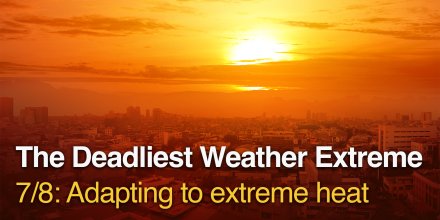
Webinar: Climate Data Tools for Resilient Urban Planning
This second webinar in the series presents digital tools that turn climate data into actionable strategies for urban resilience.

This second webinar in the series presents digital tools that turn climate data into actionable strategies for urban resilience.

Rising heat risks demand better planning, stronger warning systems, and targeted adaptation strategies.
|
|
|||||||||
|---|---|---|---|---|---|---|---|---|---|
|
Icon
|

|

|

|

|

|

|

|

|
|
|
Temperature (°F)
|
|||||||||
|
Temperature felt (°F)
|
34° |
35° |
37° |
38° |
37° |
36° |
35° |
34° |
|
|
Wind direction
|
N |
N |
N |
NNW |
NNW |
NNW |
NNW |
NW |
|
|
Wind speed (mph)
|
N
16-28
16-28
|
N
15-30
15-30
|
N
15-28
15-28
|
NNW
15-33
15-33
|
NNW
15-29
15-29
|
NNW
14-28
14-28
|
NNW
16-31
16-31
|
NW
16-33
16-33
|
|
|
Precipitation (in/3h)
|
< 0.04 in
25%
< 0.04
|
< 0.04 in
25%
< 0.04
|
-
0%
-
|
-
55%
-
|
< 0.04 in
85%
< 0.04
|
< 0.04 in
70%
< 0.04
|
< 0.04 in
30%
< 0.04
|
< 0.04 in
40%
< 0.04
|
|
|
Precipitation probability
|
25%
|
25%
|
0%
|
55%
|
85%
|
70%
|
30%
|
40%
|
|
|
Precipitation hourly
|
|||||||||
|
rainSPOT
Precipitation distribution within 20 km
|
|
Overnight into Friday the weather is changing with a mix of clear and cloudy skies and a chance of showers. As more clouds move in on Friday morning, the sky becomes overcast but it should stay dry. Friday afternoon it will be cloudy and rainy. The sun will not be visible. Precipitation is very likely with an 80% chance. Temperature highs are likely to reach 48 °F. On Friday expect a moderate breeze (12 to 18 mph). Gusts to 34 mph are possible. Winds blowing at night and in the morning from North and during the afternoon from Northwest. The weather forecast for Hartz Mountains National Park for Friday is likely to be accurate.
Pressure: 1017 hPa
Timezone: AEST (UTC +10:00h)
The location marker is placed on Hartz Mountains National Park. Orange crosses indicate lightning. Data provided by nowcast.de (available in USA, Europe, Australia). Drizzle or light snow fall might be invisible for the radar. Precipitation intensity is colour coded, ranging from turquoise to red.
The real-time satellite image combines visible light during daytime with infrared radiation during nighttime. At night, the image is not dark as infrared radiation can detect temperature differences. Unfortunately, low clouds and fog are difficult to distinguish from ground temperatures and thus can be almost invisible during the night. Meteosat satellite images for Europe are updated in real-time every 5 minutes. GOES-16/GOES-17 (North & South America) and Himawari (Asia) images update every 10 minutes.
Precipitation is estimated from radar and satellites. Precipitation estimates from satellites are less accurate at night than during daytime.
© 2025 meteoblue, NOAA Satellites GOES-16 and EUMETSAT. Lightning data provided by nowcast.

This second webinar in the series presents digital tools that turn climate data into actionable strategies for urban resilience.

Rising heat risks demand better planning, stronger warning systems, and targeted adaptation strategies.
Advertising is essential to maintain our free website with unique detail and accuracy.
Please whitelist www.meteoblue.com on your ad blocker or consider buying one of our products:
Already have a subscription?
Then please login.